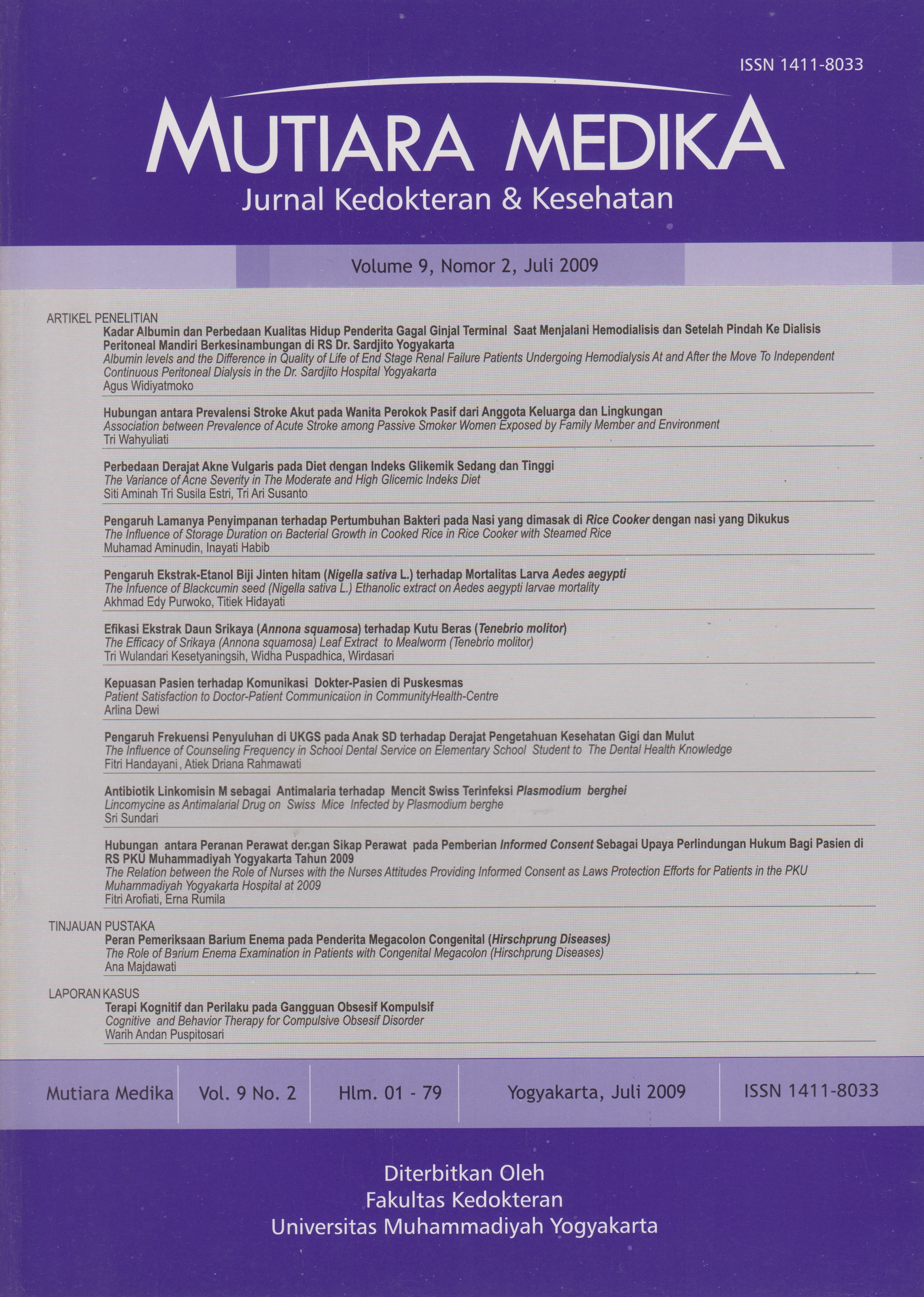Pengaruh Ekstrak-Etanol Biji Jinten hitam (Nigella sativa L.) terhadap Mortalitas Larva Aedes aegypti
DOI:
https://doi.org/10.18196/mmjkk.v9i2.1600Keywords:
Aedes aegypti, larva, mortalitas, Nigella sativa, mortality, Nigella sativa AbstrakAbstract
The various type of plant used as the biological resource which is necessary for human being. Many kind of plan was exploited as an insecticidal, because of the active ingredient which present in the plant. Nigella Sativa was one of the plants which relatively peaceful and not dangerous to the environment, but its potential to restrain insect specifically for mosquito have never been studied. The purpose of this research is to know the influence of ethanol extract of Nigella sativa to the Ae. aegypti larvae mortality. This research conducted the mortality test of mosquito according the WHO techniques for susceptibility of insecticide on mosquitoes use 9 concentration of Nigella sativa extract: 1%; 0,8%; 0,6%; 0,4%; 0,3%; 0,2%; 0,1%; 0,05%; 0,025% and 0%. The larva mortality data analyzed with Anava and analyze with probit analysis to determine the value LC50 (in 24 hour). The result of mortality test shows that the excelsior of ethanol extract of Nigella sativa concentration caused larva death especially in 24 hour first. At highest concentration that is 1% more than 95% larva was dead. The probit analysis gave the LC50for 24 hours at 0,47%. It can be concluded that ethanol extract of Nigella sativa had an Aedes aegypti larvacide effect.
Berbagai jenis tumbuhan berlaku sebagai sumber daya hayati yang penting bagi manusia, karena kandungan bahan aktif dalam tumbuhan tersebut dapat dimanfaatkan diantaranya sebagai insektisida. Jinten hitam (Nigella sativa) adalah salah satu tumbuhan yang relative aman dan tidak berbahaya bagi lingkungan, namun pemanfaatannya untuk pengendalian serangga belum pernah digunakan. Tujuan penelitian ini adalah untuk mengetahui pengaruh ekstrak etanol Nigella sativa terhadap mortalitas larva Aedes aegypti. Pada penelitian ini dilakukan uji mortalitas dengan cara menurut WHO dengan 9 konsentrasi ekstrak Nigella sativa 1%; 0,8%; 0,6%; 0,4%; 0,3%; 0,1%; 0,05%; 0,025% and 0%. mortalitas larva dianalisis menggunakan Anava dan analisis probit untuk menentukan nilai LC50 (24 jam). Hasil penelitian uji mortalitas menunjukkan bahwa ekstrak etanol Nigellasativa semakin tinggi konsentrasi akan semakin tinggi pula kematian larva terutama untuk 24 jam pertama. Pada konsentrasi tertinggi yaitu 1% didapati lebih dari 95% larva mati. Hasil analisis probit diperoleh nilai LC50 dalam 24 jam adalah kadar 0,47%. Dapat disimpulkan bahwa ekstrak etanol Nigella sativa mempunyai efek larvasida pada nyamuk Aedes aegypti.
References
Munif,BS. dan Sutarno 1994. Efektivitas ekstrak biji bengkuang Pachyrrhyzus erosus terhadap larva Culex Quenquefasciatus di Laboratorium. Majalah parasitologi Indonesia. Vol. 7 (1). Diterbitkan oleh Perkumpulan Pemberantasan penyakit Parasit Indonesia.
Gandahusada, S., W Pribadi, dan H. Ilahude. 1998. Parasitologi Kedokteran. UI Press. Jakarta.
Mardihusodo, SJ., CA. Baidowi, dan Mardhijah. 1987. Pengamatan segi- segi Biologi Aedes aegypti di Laboratorium. Prosiding Konggres Entomologi II. Perhimpunan Entomologi Indonesia. Jakarta. 15 hal.
Hardini, 2008, Gambaran Manajemen Program Penanggulangan Penyakit Demam Berdarah Dengue (P2DBD) di Puskesmas Kecamatan Pasar Minggu Tahun 2008, www.digilib.ui.ac.id/opac/themes/libri2/detail.jsp?id=123537&lokasi=lokal
Supartha, I.W., 2008, Pengendalian Terpadu Vektor Virus Demam Berdarah Dengue, Aedes aegypti (Linn.) dan Aedes albopictus (Skuse)(Diptera: Culicidae), http:// dies.unud.ac.id/wp-content/uploads/ 2008/09/makalah-supartha-baru.pdf
Kardinan, A., 2007, Potensi Selasih Sebagai Repellent Terhadap Nyamuk Aedes Aegypti. Jurnallitri. 13 (2) 39-42
Astuti,Rr.,U.N.W, 2004, Pengaruh Ekstrak-Etanol Daun Mindi Melia azedarach L. terhadap Daya Tetas Telur , Perkembangan Dan Mortalitas Larva Aedes aegypti, Seminar Peringatan Hari Nyamuk IV. Tropical Disease Center - Universitas Airlangga. Surabaya.
El-Mahdi, MA., 2005, Thymoquinone induces apoptosis through activation of caspase-8 and mitochondrial events in p53-null myeloblastic leukemia HL-60 cells. http://www.ncbi.nlm.nih.gov/pubmed/ 15906362?itool=EntrezSvstem2.P Entrez.Pubmed.Pubmed ResultsPanel. Pubmed RVDocSum&ordinalpos=5
Downloads
Published
Issue
Section
License
Copyright
Authors retain copyright and grant Mutiara Medika: Jurnal Kedokteran dan Kesehatan (MMJKK) the right of first publication with the work simultaneously licensed under an Attribution 4.0 International (CC BY 4.0) that allows others to remix, adapt and build upon the work with an acknowledgment of the work's authorship and of the initial publication in Mutiara Medika: Jurnal Kedokteran dan Kesehatan (MMJKK).
Authors are permitted to copy and redistribute the journal's published version of the work (e.g., post it to an institutional repository or publish it in a book), with an acknowledgment of its initial publication in Mutiara Medika: Jurnal Kedokteran dan Kesehatan (MMJKK).
License
Articles published in the Mutiara Medika: Jurnal Kedokteran dan Kesehatan (MMJKK) are licensed under an Attribution 4.0 International (CC BY 4.0) license. You are free to:
- Share — copy and redistribute the material in any medium or format.
- Adapt — remix, transform, and build upon the material for any purpose, even commercially.
This license is acceptable for Free Cultural Works. The licensor cannot revoke these freedoms as long as you follow the license terms. Under the following terms:
Attribution — You must give appropriate credit, provide a link to the license, and indicate if changes were made. You may do so in any reasonable manner, but not in any way that suggests the licensor endorses you or your use.
- No additional restrictions — You may not apply legal terms or technological measures that legally restrict others from doing anything the license permits.



